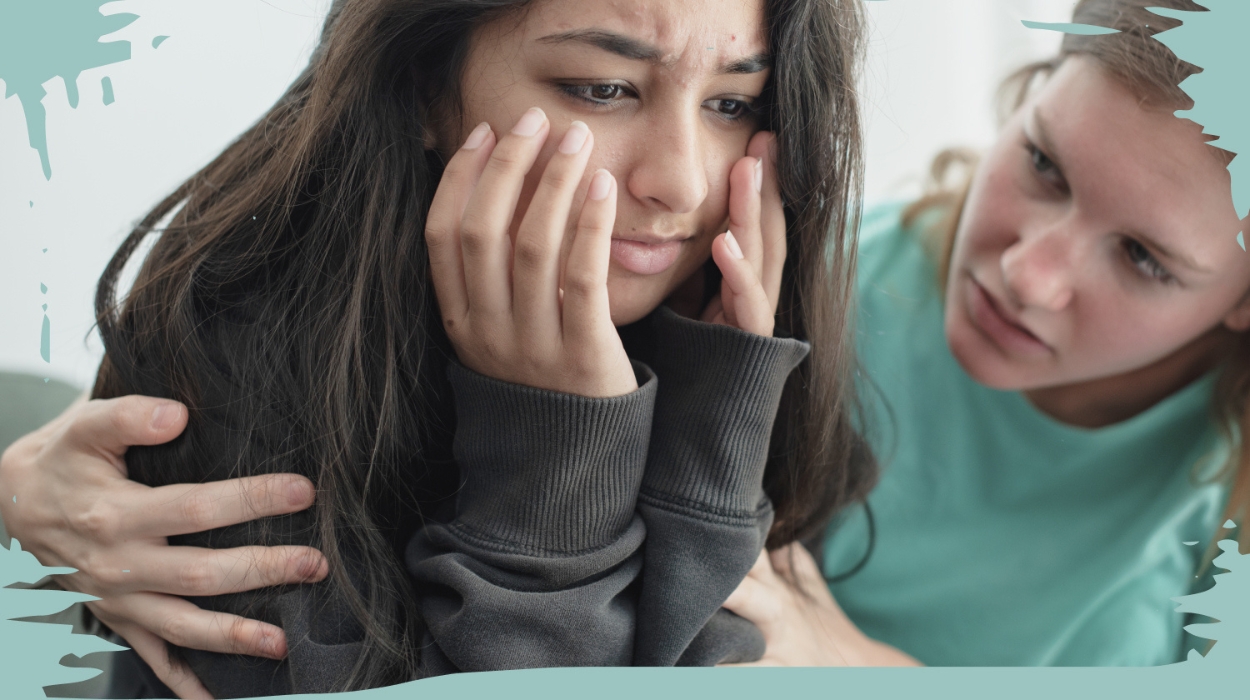Panic attacks are common for individuals with anxiety or panic disorders. The sudden onset of symptoms, including shortness of breath, chest pain, and fear, can be overwhelming and scary. It is essential to recognize the signs of a panic attack and know how to help someone experiencing it. If left untreated, panic attacks can worsen and become more frequent, causing significant distress in a person’s life. The good news is that there are effective ways to help someone during a panic attack. Breathing exercises, relaxation techniques, and grounding methods are some of the strategies that can provide immediate relief.
By understanding and implementing the right strategies, you can help someone feel calmer and more in control during a panic attack. Moreover, seeking ongoing professional help can help manage panic attack symptoms and improve a person’s quality of life. In this article, we will discuss how to identify the warning signs of a panic attack, ways to help someone during an intense episode and offer ongoing support to manage recurring panic attacks.
Tips to Help Someone Having a Panic Attack
Here are some quick things you can do to help someone who is having a panic attack:
Signs a Person is Having a Panic Attack
Symptoms of panic attacks can be overwhelming and distressing. They can occur suddenly without warning and can last for several minutes or more. Symptoms can be physical, emotional, and psychological. Physical symptoms can include a racing heartbeat, sweating, trembling or shaking, shortness of breath or hyperventilation, chest pain, nausea, and dizziness. Panic attacks can also cause a feeling of choking or being smothered, as well as hot flashes or chills.
Emotional symptoms may include a feeling of impending doom, fear, or terror and a sense of being disconnected from oneself or reality. Psychological symptoms may consist of losing control or going crazy and even feeling like you’re having a heart attack or dying.
Panic attacks can also trigger a sense of being overwhelmed, making it difficult to concentrate, focus, or stay calm. It is not uncommon to feel like you’re losing your mind or have no control over your body. These symptoms can make a person feel like they’re in danger or experiencing a life-threatening situation, leading to further anxiety and panic.
It is important to note that not everyone who experiences panic attacks will have all these symptoms. Some people may have just a few symptoms, while others may experience a combination of physical, emotional, and psychological symptoms. Seeking professional help and support can help manage and alleviate symptoms of panic attacks.
How to Help Someone Having a Panic Attack?

Create a Safe Environment and Stay Calm
Try to move the person to a quiet and safe environment, away from potential triggers.
One of the most important things you can do to help someone having a panic attack is to remain calm. Being visibly upset or agitated can exacerbate the person’s anxiety and worsen the situation. Speak in a calm, reassuring voice and avoid using an accusatory or dismissive tone.
Respect Their Needs
During a panic attack, the person may need space and privacy to feel safe and regain control of their emotions. If the person asks to be left alone, try not to take it personally and respect their wishes. On the other hand, if they express a need for physical contact or reassurance, offer a gentle hug or hand squeeze if appropriate and within their comfort zone.
Validate Their Feelings
It’s important to let the person know their feelings are valid and understandable. Avoid downplaying their experience or telling them to “just relax.”
Encourage Them to Breathe
Panic attacks can cause rapid breathing, which can make the symptoms worse. Encourage the person to take slow, deep breaths to help regulate breathing.
Offer Physical Comfort
Physical touch can be a comforting gesture during a panic attack. Ask the person if they would like a hug or to hold your hand.
Ask How You Can Help
Every person experiences panic attacks differently, so it’s important to ask the person how you can best support them. Some people may prefer to be left alone, while others may need more support.
Know When to Seek Medical Attention
If the person’s symptoms are severe or do not subside, it may be necessary to seek medical attention. Offer to accompany them to the hospital or call for emergency services if needed.
Remember, everyone experiences panic attacks differently and may have different preferences for how they want to be helped. It’s important to listen to the person’s needs and let them guide you on what would be most helpful. In general, offering support, being patient and compassionate, and providing a safe and calm environment can go a long way in helping someone through a panic attack.
What to Avoid to Make a Panic Attack Worse

Experiencing a panic attack can be an overwhelming and distressing experience. If you or someone you know is dealing with panic attacks, it’s important to know what triggers to avoid to make things worse. Here are some things to avoid during a panic attack:
- Avoid fighting the symptoms: Trying to resist or fight the symptoms of a panic attack can make them more intense. Instead, accept them as they come and focus on breathing deeply.
- Avoid caffeine and stimulants: Stimulants like caffeine can increase heart rate and trigger feelings of anxiety, so it’s best to avoid them during a panic attack.
- Avoid negative thoughts: Avoid engaging in negative thoughts or self-talk that can worsen anxiety. Instead, focus on positive affirmations and calming thoughts.
- Avoid isolating yourself: Isolating yourself during a panic attack can worsen the symptoms. Try to be with someone who can offer support or distract you from the attack.
- Avoid shallow breathing: Shallow breathing can increase anxiety and panic, so try to take deep breaths from the diaphragm.
- Avoid panic-inducing situations: Try to avoid situations that trigger panic attacks or cause anxiety. If you can’t avoid them, prepare yourself mentally by practicing relaxation techniques.
Knowing what to avoid during a panic attack can better manage your symptoms and prevent the situation from worsening.
When to Seek Medical Assistance
It is crucial to know when to seek medical assistance for panic attacks. If you or someone you know is experiencing panic attacks, it is essential to seek medical attention if the symptoms are severe or persistent. Seeking medical assistance is particularly crucial if you have chest pain, shortness of breath, or a history of heart disease. If you are experiencing symptoms interfering with your daily life, it is essential to seek medical attention. Additionally, seeking medical help is necessary if you have recurring panic attacks, as they can indicate panic disorder, a type of anxiety disorder. It is crucial not to delay seeking medical attention, as untreated panic attacks can lead to severe anxiety and depression. A mental health professional can help evaluate your symptoms and develop a treatment plan that suits your needs. Remember that there is no shame in seeking help, and the right treatment can help manage panic attacks and improve overall mental health.
Long-term Help for Panic Disorder
Long-term help for panic disorder involves a combination of medication and therapy. Antidepressants, anti-anxiety drugs, and beta-blockers are commonly prescribed to help manage symptoms. Cognitive-behavioral therapy (CBT) is a form of therapy that has been shown to be effective in treating panic disorder. It helps individuals identify and change negative thought patterns and behaviors that contribute to panic attacks. Other forms of therapy, such as exposure therapy and psychodynamic therapy, may also be helpful.
Lifestyle changes can also be beneficial in managing panic disorder in the long term. Regular exercise, healthy eating, and good sleep hygiene can all contribute to reducing stress and improving overall mental health. Avoiding caffeine, alcohol, and nicotine can also help reduce the frequency and severity of panic attacks.
It is important to continue with treatment and make lifestyle changes even after symptoms improve to prevent relapse. If symptoms worsen or do not improve with treatment, seeking medical assistance and re-evaluating the treatment plan is important.
Conclusion
In conclusion, panic attacks can be overwhelming and disruptive, but there are various ways to manage them. It’s important to recognize the symptoms of a panic attack and to take steps to help oneself or someone else during an episode. While short-term techniques like deep breathing and grounding can be helpful at the moment, seeking professional help and long-term treatment for panic disorder is crucial for managing symptoms and improving overall mental health. It’s important to avoid triggers and learn coping mechanisms to prevent panic attacks from worsening. Staying informed and seeking support can make a significant difference in managing panic disorder in the long run. Remember, seeking medical attention when needed is always important, and there are resources available for those who need ongoing help with managing panic attacks and related disorders. With the right tools and support, managing and overcoming panic disorder is possible.
Frequently Asked Questions
A panic attack is a sudden onset of intense fear or discomfort, which may include physical symptoms such as heart palpitations, sweating, and shortness of breath.
Panic disorder is a type of anxiety disorder characterized by recurring panic attacks and persistent fear of future attacks.
You can help someone having a panic attack by staying calm, respecting their needs, and encouraging them to breathe deeply and focus on their surroundings.
Avoiding caffeine, alcohol, and other stimulants and trying not to catastrophize the situation can help prevent panic attacks from worsening.
If you experience frequent or severe panic attacks, it is recommended that you seek medical assistance to rule out any underlying medical conditions and receive appropriate treatment.
Long-term treatment options for panic disorder may include cognitive-behavioral therapy, medication, and lifestyle changes such as regular exercise and stress management techniques.
While there is no known cure for panic disorder, with proper treatment and management, many individuals are able to manage their symptoms and improve their quality of life effectively.
While panic attacks are a symptom commonly associated with anxiety disorders, they are not the same. Anxiety disorders encompass a range of conditions characterized by excessive and persistent fear or worry, while panic attacks are a sudden onset of intense fear or discomfort.
